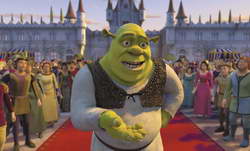

 A new breed of film animators is giving Pixar and Dreamworks a run for
their money - and wowing Cannes. Mark Harris reports from the red carpet.
A new breed of film animators is giving Pixar and Dreamworks a run for
their money - and wowing Cannes. Mark Harris reports from the red carpet.Away from the famous directors and perma-tanned starlets on the red carpets,
a quiet revolution is taking place at this year’s Cannes Film Festival.
In a small viewing room at the American Pavilion, technology giant HP is showcasing
a dozen short films that have the potential to turn the world of animated film
production on its head. With impressive 3D graphics, creative storylines and naturalistic
fur and water effects, these films look similar to Hollywood productions such
as Dreamworks’ summer blockbuster Madagascar. The production of Madagascar
used over 1000 dual processor computers, an army of professional animators, cutting
edge Virtual Studio technology and had a multi-million dollar budget. In contrast,
the 12 films at Cannes have been created in the UK by tiny companies or even individuals,
some of them working with a single home computer.
The films were made possible by the SE3D project, a joint venture between Bristol
media organisation Watershed and HP, using the concept of utility computing. Just
as none of us filter our own water or generate our own electricity, utility computing
aims to use remote computers to outsource the processing of data, whether it’s
for financial analysis, gene sequencing or even car crash testing.
The latest 3D animated films are especially suited to utility computing because
of the enormous amount of computing power required for rendering – the process
of turning basic wire-frame figures into fully textured and realistically illuminated
objects. Dan Lane, director of the SE3D film Two Fellas, explains. “Two
Fellas was a film I wanted to make for a while, although I initially planned on
doing it all myself. Each of the film’s 5,500 frames would have taken well
over an hour to render on my own computer. I was looking at 18 months just to
render my four-minute film, and that’s assuming my computer worked around
the clock and nothing went wrong.”
 Utility
computing
Utility
computing
SE3D offered Lane and his fellow UK-based animators free access to HP’s
utility rendering service (URS) in Palo Alto, California, which is home to over
100 powerful servers. “SE3D made it infinitely easier to achieve my goal,”
says Lane. “I simply installed some software, logged in and sent the source
files over the internet. I then receiving the rendered images back, sometimes
in a matter of minutes.”
Peter Toft, project manager at HP Labs in Bristol, is quick to point out that
utility services, and even render ‘farms’ serving animators, are nothing
new. Nearly 95 per cent of animated films worldwide are made using 3D software
and HP has been working with the major studios for some time. When making Shrek
2, for instance, Dreamworks used a URS from HP consisting of 500 dual-processor
servers running Linux, each configured with 4Gb of memory and fed by a 4 Terabyte
NFS storage system. Ultimately, over a million frames were rendered, consuming
more than 100 processor ‘years’ and contributing over 10 per cent
of the frames used in the final film. It was the first time that a major animation
studio had out-sourced its rendering, and Dreamworks was rewarded with the highest
ever box office takings for an animated film.
Toft believes the advantages of utility computing for large studios have been
proven. “Animators can call on extra capacity when they need: for rush jobs;
to meet theatrical deadlines; or if a rendering job is larger than expected.”
But HP’s scaling down of the technology for use by smaller film-makers is
a real step forward, he claims. “Most render farm technology is immature
and doesn’t work well over low bandwidths, such as regular consumer broadband.
We’ve developed compression and management technologies that make best use
of the limited bandwidth, and use strong encryption to prevent finished frames
ending up in the wrong hands.”
“Another problem is managing a multi-user environment. How do you decide
who gets the computing power on offer? SE3D uses a market system where users get
allocated processor time on the basis of their bids in a succession of auctions,
a little like eBay. The more you pay, the faster your job will get done.”
Although the experimental SE3D system used virtual cash to give independent film-makers
access to the technology, HP believes that a commercial launch of its URS will
cost studios only about one tenth as much as buying, installing and maintaining
their own render farms.
This cost reduction can’t come a moment too soon for European studios, whose
animated features typically have budgets just 10 per cent the size of their Hollywood
rivals and who are currently struggling to attract audiences to their cheaper,
less computer intensive 2D films. American studios largely abandoned 2D films
following Disney’s high-profile 2D flop Treasure Planet, prompting Chief
Executive Michael Eisner to proclaim: “The 2D business is coming to an end,
just like black and white came to an end.”
 The
future of animation
The
future of animation
The introduction of affordable utility rendering services could ensure
a future for smaller animation houses – or it could make studios irrelevant
altogether, suggests HP’s Peter Toft. “Today, animation is largely
in the context of a production house,” he notes. “But with widespread
utility computing, virtual communities could come together from all over the world
to attack large projects.”
Tim Westcott, an analyst at Screen Digest, is more sceptical. “Distribution
is incredibly important in the movie business. If you don’t have one of
the major studios behind you and aren’t able to get distribution in the
US, you face an uphill battle. Animation, even low budget animation, is very expensive
to make. Most people funding animation are looking for a mainstream hit if they
can get it.”
While it seems unlikely that a lone animator or virtual studio will be scooping
the Palme D’Or at Cannes next year, utility computing could at least ensure
that home-grown animators have the chance to compete with Hollywood on a level
playing field. As film-maker Dan Lane says, “This technology opens up the
possibility for small, independent companies to make stuff that just makes people
go wow.” And if films like Shrek 2 are anything to judge by, where wows
go, success soon follows.
Event: Future of Animation discussion at the Cheltenham Science Festival, Friday 10 June, 8.15pm. £6/£5. www.cheltenhamfestivals.co.uk, 01242 227979.
Here's the full story on the Indy's website (apologies, it's a pay link).